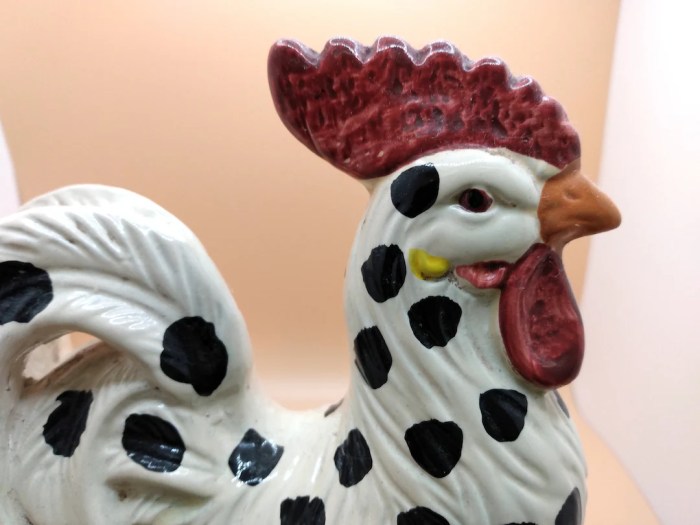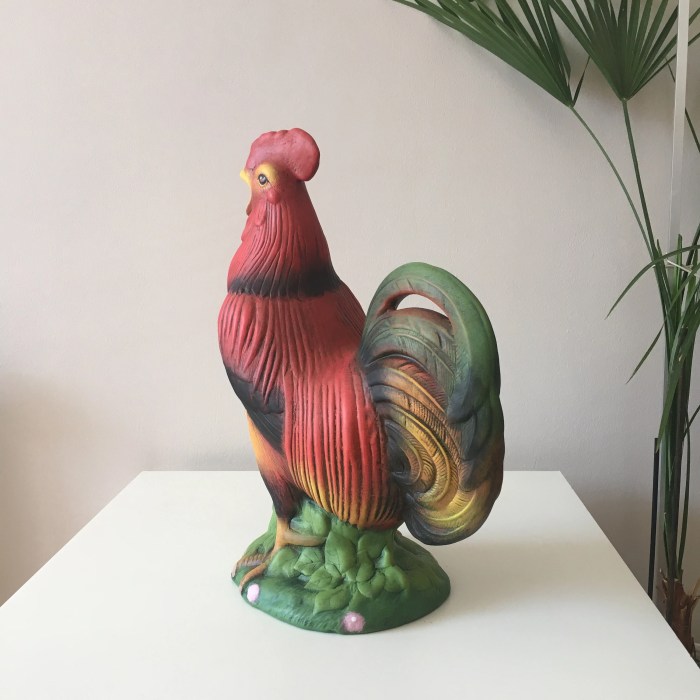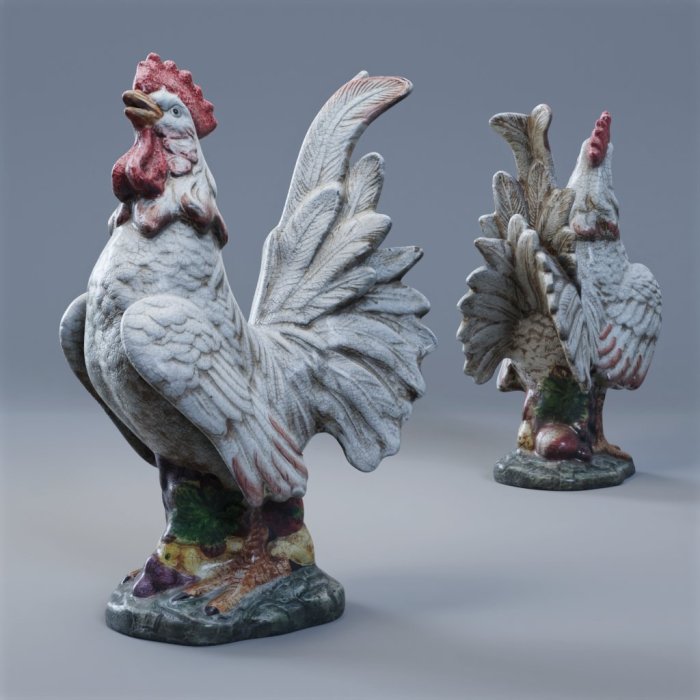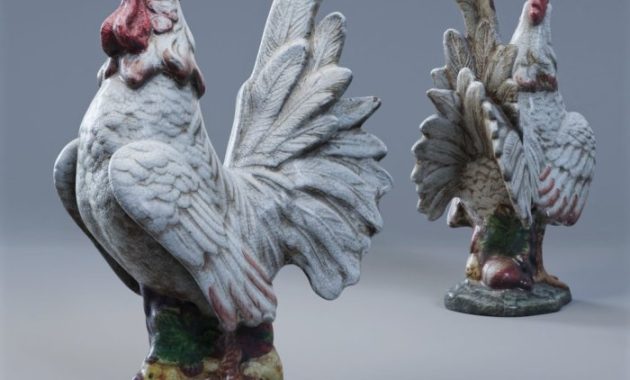Market Overview of Ceramic Rooster Kitchen Decor
Ceramic rooster kitchen decor – The ceramic rooster, a symbol of good luck, prosperity, and the dawn of a new day, has found a charming niche in the world of kitchen decor. This seemingly simple motif has evolved into a vibrant market segment, attracting both seasoned collectors and design-conscious homeowners. Understanding the current market trends and consumer preferences is key to navigating this increasingly popular area.
Current Market Trends in Ceramic Rooster Kitchen Decor
The market for ceramic rooster kitchen decor is experiencing steady growth, fueled by a resurgence of interest in farmhouse-style aesthetics and a desire for unique, statement pieces. Consumers are increasingly seeking handcrafted items with unique glazes and finishes, moving away from mass-produced, uniform designs. The trend leans towards rustic charm, incorporating natural elements and earthy tones. Personalized and customized roosters, perhaps with specific colors or inscriptions, are also gaining traction.
Ceramic rooster kitchen decor offers a charming, rustic aesthetic, perfect for adding personality to a farmhouse-style kitchen. This playful motif complements other decorative elements, including the vibrant displays achievable with kitchen plate wall decor , which can further enhance the overall theme. Ultimately, a ceramic rooster, strategically placed amongst a curated collection of plates, creates a truly unique and memorable kitchen space.
Furthermore, the market shows a growing demand for sustainable and ethically sourced ceramic products, reflecting a broader consumer shift towards conscious consumption.
Key Demographics Interested in Ceramic Rooster Kitchen Decor
The primary demographic interested in ceramic rooster kitchen decor includes homeowners aged 35-65, with a higher concentration in the 45-55 age bracket. These individuals often value traditional aesthetics combined with a touch of whimsy. They tend to be homeowners with established households, actively engaged in creating a comfortable and personalized living space. While the core demographic skews slightly towards women, a significant portion of male consumers also appreciate the rustic charm and symbolic meaning of the rooster.
This market also extends to those interested in collecting unique and handcrafted kitchenware.
Pricing Strategies of Ceramic Rooster Kitchen Decor Sellers
Pricing strategies vary significantly depending on factors such as the size, intricacy of design, materials used, and the level of craftsmanship involved. Smaller, simpler roosters may be priced affordably, ranging from $20-$50, targeting a broader market segment. Mid-range pieces, characterized by more detailed designs and higher-quality materials, typically range from $50-$150. High-end ceramic roosters, often handcrafted by renowned artists or featuring unique glazes and techniques, can command prices exceeding $200, appealing to collectors and those seeking luxury items.
Some sellers employ a tiered pricing structure, offering various options to cater to different budget levels. Online marketplaces offer a wider range of pricing due to reduced overhead costs compared to brick-and-mortar stores.
Price Points and Corresponding Features of Ceramic Rooster Kitchen Decor
| Price Range | Size (approx.) | Material | Features |
|---|---|---|---|
| $20-$50 | Small (4-6 inches) | Standard ceramic | Simple design, basic glaze |
| $50-$150 | Medium (6-10 inches) | High-fired ceramic, possibly stoneware | More detailed design, unique glaze, hand-painted details |
| $150-$300 | Large (10-14 inches) | High-quality ceramic, potentially incorporating other materials | Intricate design, artist-signed, unique finish (e.g., crackle glaze) |
| $300+ | Variable | High-end ceramic, possibly limited edition | Exceptional craftsmanship, unique artistic style, collector’s item |
Design Styles and Aesthetics: Ceramic Rooster Kitchen Decor

The charm of ceramic rooster kitchen decor lies not just in its whimsical subject matter, but also in its remarkable versatility across a range of design styles. From rustic farmhouse kitchens to sleek modern spaces, the ceramic rooster adapts, bringing its unique personality to each aesthetic. The careful selection of design, color, and size allows for seamless integration into any existing decor scheme, enhancing the overall ambiance.The versatility of ceramic rooster kitchen decor is largely due to its adaptability to different design aesthetics and the wide range of color palettes and forms available.
This allows homeowners to find a piece that perfectly complements their existing kitchen style, whether it’s a cozy farmhouse setting or a minimalist modern space.
Design Styles
Ceramic roosters effortlessly traverse various design styles. A rustic rooster might boast a weathered, earthy glaze, perhaps with visible brushstrokes, evoking the charm of a countryside farm. In contrast, a modern farmhouse rooster might be painted in crisp white or muted pastels, with clean lines and a slightly minimalist design. Vintage-inspired roosters often feature antique-style finishes, perhaps with crackled glazes or distressed paint, reflecting a sense of nostalgia and old-world craftsmanship.
They can also incorporate elements of Art Deco or mid-century modern aesthetics, demonstrating the breadth of stylistic possibilities.
Color Palettes
The color palettes associated with ceramic rooster kitchen decor are as diverse as the styles themselves. Rustic styles often employ earthy tones like terracotta, deep browns, muted greens, and creams. Modern farmhouse designs frequently feature whites, creams, soft blues, and gentle grays. Vintage roosters might embrace bolder colors, including jewel tones like emerald green, sapphire blue, or ruby red, depending on the specific vintage style being emulated.
More contemporary designs may utilize bright, saturated colors or even metallic finishes for a striking effect.
Sizes and Shapes
The size and shape of a ceramic rooster significantly impact its visual presence in a kitchen.
Consider these examples:
- Small Roosters (under 6 inches): These charming miniatures are perfect for adding subtle pops of color and personality to shelves, windowsills, or even as part of a larger collection.
- Medium Roosters (6-12 inches): This size range offers a versatile option, suitable for placement on countertops, tabletops, or as a focal point on a kitchen island.
- Large Roosters (over 12 inches): Statement pieces, large roosters command attention and can serve as striking decorative elements, anchoring a kitchen’s design scheme. They can even be incorporated as wall art.
Beyond size, the shapes also vary considerably. Some roosters are realistically sculpted, while others are stylized or even cartoonish. Some might be perched, others standing proudly, and still others might be depicted in mid-stride.
Unique Ceramic Rooster Designs
Here are three unique ceramic rooster designs, showcasing the breadth of creative possibilities:
- Rustic Charm Rooster: This piece is crafted from terracotta clay, with a hand-painted design featuring muted browns, greens, and creams. The glaze is intentionally uneven, creating a rustic, aged appearance. The rooster is realistically sculpted, with detailed feathering and a slightly weathered look. It stands approximately 8 inches tall.
- Modern Minimalist Rooster: This rooster is made from white stoneware, with clean, simple lines and a matte finish. It’s painted in a soft, muted gray, with subtle black detailing on the comb and wattle. Its design is highly stylized, almost abstract, and it sits approximately 6 inches tall.
- Vintage Glam Rooster: This piece is crafted from a high-fired porcelain, featuring a glossy, jewel-toned emerald green glaze. It is adorned with gold accents on the beak, legs, and tail feathers, adding a touch of vintage glamour. The rooster is realistically sculpted, with intricate detailing, and it stands approximately 10 inches tall.
Customer Reviews and Feedback

The clucking chorus of customer opinions offers a rich tapestry of insights into the world of ceramic rooster kitchen decor. Analyzing these reviews reveals not only what customers love, but also where improvements can be made, painting a vivid picture of the market’s strengths and weaknesses. By examining common themes, we can better understand the factors that drive both satisfaction and dissatisfaction among consumers.
Positive reviews frequently highlight the charming aesthetic appeal of ceramic roosters, their ability to add a touch of rustic charm or whimsical personality to a kitchen, and their durability. Negative reviews, on the other hand, often center on issues of quality control, such as chipping paint or uneven finishes. Price points also play a significant role, with some customers feeling the cost doesn’t justify the perceived quality.
Comparing feedback across different brands reveals interesting trends, with some manufacturers consistently praised for superior craftsmanship while others struggle with inconsistent product quality.
Common Themes in Customer Reviews
Customer feedback reveals a recurring pattern of appreciation for the decorative value of ceramic roosters. Many describe them as charming additions that bring a touch of personality and rustic elegance to their kitchens. However, a significant number of negative reviews express concern over the fragility of some products, with reports of breakage during shipping or minor handling. Another recurring theme is the variation in quality between different brands and even within the same brand’s product lines.
Some customers report receiving pieces with imperfections, such as uneven paint application or slight warping.
Factors Contributing to Positive and Negative Customer Experiences
Positive customer experiences are strongly correlated with high-quality craftsmanship, attractive design, and reasonable pricing. Reviews praising specific brands often mention the use of durable materials, meticulous detailing, and a charming overall aesthetic. Conversely, negative experiences are frequently linked to poor quality control, leading to chipped paint, cracks, or other imperfections. Issues with packaging and shipping, resulting in damage during transit, also contribute to negative feedback.
Furthermore, inflated pricing for items perceived as low quality generates significant dissatisfaction.
Comparison of Customer Feedback on Different Brands or Styles
While specific brand names are avoided to maintain neutrality, a clear distinction emerges between reviews for higher-end and lower-end ceramic rooster decor. Higher-priced items, generally crafted with more attention to detail and from higher-quality materials, receive consistently positive feedback for their durability and aesthetic appeal. Lower-priced items, often mass-produced, tend to attract more criticism regarding quality control and durability.
Similarly, styles differ in popularity. Rustic, vintage-inspired designs generally receive more positive comments than overly stylized or cartoonish representations.
Hypothetical Customer Review
“This ceramic rooster is absolutely adorable! The detail work is amazing, and it looks perfect perched on my kitchen shelf. It adds a lovely touch of farmhouse charm. However, the packaging was flimsy, and it arrived with a tiny chip on its beak. It’s not overly noticeable, but for the price I paid, I expected it to arrive in perfect condition. I’d recommend this rooster to others, but perhaps with a warning about potential shipping damage.”
Future Trends and Predictions

The ceramic rooster, a charming symbol of rural life and bountiful harvests, is poised for an exciting evolution in kitchen decor. While its classic appeal remains strong, shifts in design aesthetics and consumer preferences will shape its future trajectory, leading to innovative interpretations and a broadened market appeal. We can expect to see a fascinating interplay between tradition and modernity in the coming years.The next five years will witness a dynamic shift in the ceramic rooster’s presence in the kitchen.
This evolution will be driven by several key factors, encompassing both design innovations and evolving consumer tastes.
Emerging Design Trends
We anticipate a move away from strictly traditional representations of the rooster. While classic, realistically rendered roosters will maintain their appeal, we’ll see a surge in more stylized and abstract interpretations. Think minimalist designs emphasizing clean lines and geometric forms, or roosters integrated into larger, more complex ceramic wall art pieces. Bold color palettes, including matte finishes and metallic accents, will add a contemporary twist to this classic motif.
We might also see a rise in playful, whimsical designs featuring roosters in unexpected poses or settings, appealing to a younger demographic. For example, imagine a rooster perched atop a stack of vintage cookbooks, or a collection of smaller roosters forming a quirky, colorful border around a kitchen window.
Material and Technological Innovations, Ceramic rooster kitchen decor
The incorporation of new materials and technologies will also significantly impact the production and appearance of ceramic rooster kitchen decor. The use of 3D printing, for example, could allow for greater design flexibility and the creation of more intricate, detailed pieces. Experimentation with glazes will lead to a wider array of colors and finishes, including iridescent effects and textured surfaces.
Sustainable and eco-friendly materials, such as recycled clay and low-impact glazes, will also gain traction, aligning with growing consumer demand for environmentally conscious products. Imagine a line of ceramic roosters crafted from recycled porcelain, boasting a unique, speckled finish achieved through the innovative use of recycled glass fragments in the glaze.
Shifting Consumer Preferences
Consumer preferences are expected to influence the future of ceramic rooster kitchen decor in several ways. The increasing popularity of farmhouse and rustic styles will continue to fuel demand for traditional rooster designs. However, a growing interest in eclectic and maximalist aesthetics will also create space for more unconventional and visually striking interpretations. Personalization will also become increasingly important; consumers will seek out unique, handcrafted pieces that reflect their individual style and personality.
For instance, custom-designed roosters incorporating family names or initials, or pieces showcasing specific regional motifs, could become highly sought after. The desire for functional art will also be a driving force, with ceramic roosters integrated into kitchen tools and utensils, such as salt and pepper shakers, or incorporated into practical items such as trivets or utensil holders.
Five-Year Forecast
Over the next five years, we foresee a diversification of the ceramic rooster kitchen decor market. Traditional styles will remain relevant, but they will be complemented by a wider range of modern and eclectic designs. The adoption of new technologies and sustainable materials will enhance both the aesthetic appeal and environmental responsibility of these pieces. The market will become increasingly segmented, catering to diverse consumer preferences and styles.
We anticipate a rise in personalized and handcrafted items, as well as a growing integration of ceramic roosters into functional kitchenware. The overall market is expected to see steady growth, driven by the enduring appeal of the rooster motif and the ongoing evolution of design trends within the kitchen decor sector. The success of companies like Anthropologie, known for their eclectic mix of vintage and modern home goods, suggests a strong market for unique and personalized kitchen décor, indicating a positive outlook for uniquely designed ceramic roosters.
Quick FAQs
Are ceramic roosters durable?
The durability of a ceramic rooster depends on the quality of the ceramic and glaze. High-quality pieces are generally quite durable, but they can chip or break if dropped or mishandled.
How do I clean a ceramic rooster?
Most ceramic roosters can be cleaned with a damp cloth and mild soap. Avoid abrasive cleaners or scouring pads, which can scratch the surface.
Where can I find ceramic rooster kitchen decor?
Ceramic rooster kitchen decor is available from various sources, including online marketplaces, home goods stores, antique shops, and craft fairs.
Are handmade ceramic roosters more expensive?
Generally, yes. Handmade ceramic roosters often command higher prices due to the craftsmanship, unique designs, and limited production runs.

